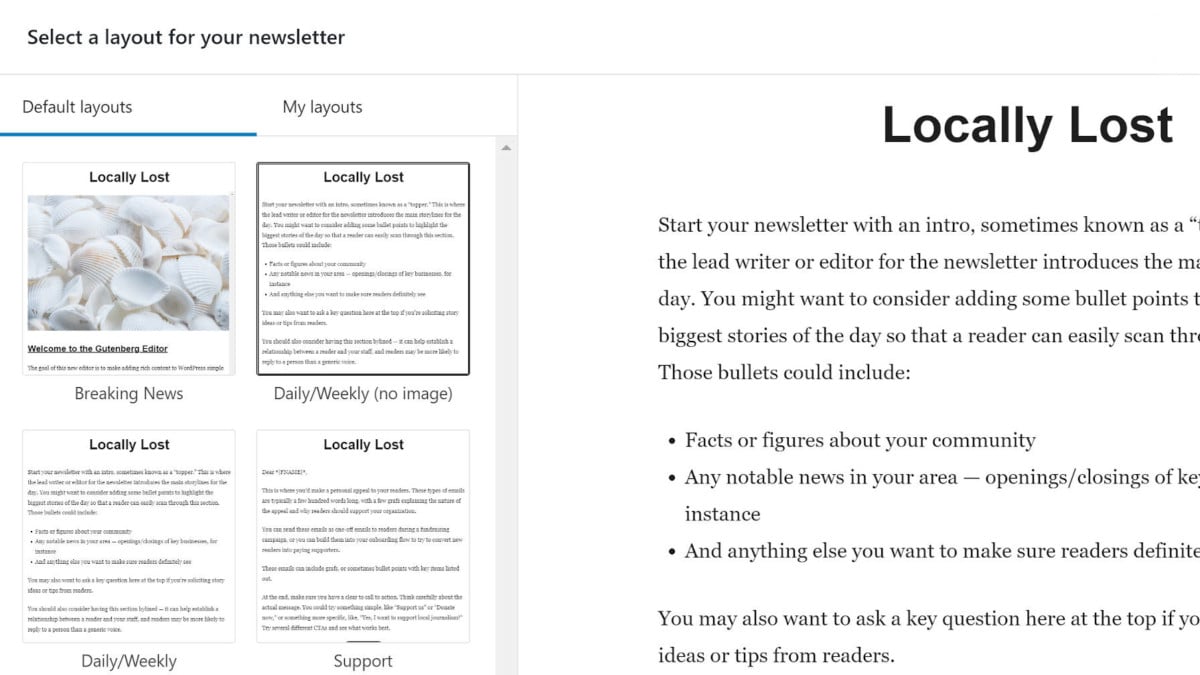Automattic released its Newspack Newsletters project to the WordPress plugin directory earlier today. It is the first Newspack-related plugin the company has made available outside of GitHub or its custom platform.
Newspack is primarily a service geared toward small and medium-sized publications. Its goal is to work with news industry leaders to create a platform for bringing WordPress to more newsrooms worldwide. El Soberano, a Chilean news publication, became the first site to launch on the service in October 2019. Earlier this month, Newspack showcased 60 sites running on the platform.
The platform is more than one theme, plugin, or service. The code is open-source, available on GitHub, and free for anyone to use via self-hosted WordPress. Each plugin is built based on feedback between publishers and the Newspack development team to solve real-world problems for publications.
The downside? Until now, the various Newspack plugins have all been hosted on GitHub, which is a developer-centric platform.
Small newsrooms may not have an onboard developer or IT team. The discoverability of necessary plugins will often happen through WordPress.org. With Newspack Newsletters landing in the plugin directory, it could be an indication of things to come.
The Newspack team should not stop with their first plugin. The entire suite of tools should be available through the plugin directory. The Newspack Blocks plugin could have uses outside of news sites. Many users might find value in its Post Carousel block or various patterns. The Newspack Content Converter bulk-converts classic WordPress posts to the block system. Even the Newspack theme and its child themes should have a home on the official WordPress theme directory.
I have reached out to the Newspack team for information on whether other plugins are coming to the directory but have not yet received official confirmation.
How the Plugin Works
Newspack Newsletters launched in July 2020. The plugin initially integrated with Mailchimp. However, the team has since added Constant Contact support. It also requires integration with Mailjet Markup Language (MJML) for transforming the HTML from WordPress into responsive markup for email clients.
After installing the plugin, users must set up the API keys from the third-party services they are using. Steve Beatty has a complete walkthrough of the process in the following YouTube video:
The plugin adds a new post type for managing newsletters. It works much the same way as any other post or page. When adding a newsletter, users are initially presented with four layout options:
- Breaking News: Displays the latest blog post and a message afterward.
- Daily/Weekly: Lists the latest posts from the blog and a section for sharing curated links from around the web.
- Daily/Weekly (No Images): An alternate version of the Daily/Weekly layout without post featured images.
- Support: A template for asking readers to support the publication.
Of course, these are only starting points. Users can begin from any of these four templates or wholly from scratch. The plugin also provides an option for saving newsletters as custom layouts.
 Selecting a layout from the newsletter screen.
Selecting a layout from the newsletter screen.
While the plugin works similarly to posts and pages, it does limit the available blocks to those more suitable for emails. This subset includes text-based blocks like Paragraph, Heading, Quote, and List. It also supports few design-type blocks, images, and the plugin’s Post Inserter block.
The user experience is straightforward. Newsletter-specific settings are in the sidebar panel. One of the simple-but-useful features is a “Styling” tab that allows users to make wholesale font and color changes for a single newsletter.
 Creating and sending a test newsletter.
Creating and sending a test newsletter.
Users can even send a test email before publishing to make sure everything is in order. This feature also makes it easy to test on a local machine before deciding if the plugin is worth using in production.
 Newsletter viewed via Gmail.
Newsletter viewed via Gmail.
Usage of the ads system was not immediately apparent. It was not until I ran a test email from the Edit Newsletter screen that I realized that the ad I had created was attached to the end of the email. Even after figuring this out, I still felt a disconnect between how ads worked for newsletters. There is a sidebar setting for disabling ads on the Edit Newsletter screen. Perhaps I am missing something, but ad placements should be a block the user can insert into the content canvas.
Despite feeling at odds with the ads system in the plugin, the overall experience was mostly smooth. The plugin is not overly complex, which can sometimes be the case when a developer attempts to add too many features. Newspack Newsletters has managed to hit that Goldilocks zone that should go over well with the average end-user.
Like this:
Like Loading…





